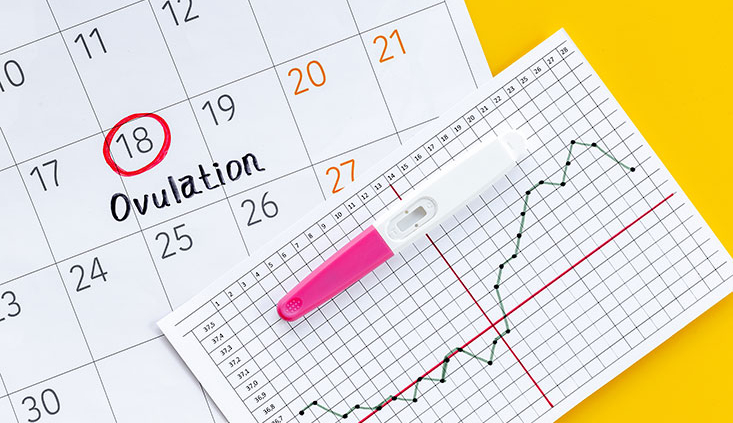How to Track Ovulation

Whether you’re facing fertility challenges or want to increase your chances of conception, understanding how to track and recognize ovulation is essential.
Ovulation is critical for achieving pregnancy, and knowing when it occurs can help you identify your most fertile days.
Keep reading to learn what ovulation is, how to recognize its signs, and how to track it effectively.
This information will help you make informed decisions about your reproductive health and enhance your chances of getting pregnant.
What Is Ovulation?
Ovulation occurs when your body releases an egg from one of your ovaries. This process is a key part of the menstrual cycle, as it allows for the possibility of pregnancy. Once released, the egg can be fertilized for about 12-24 hours. If sperm is present during this window, fertilization can occur, potentially leading to conception.
Understanding ovulation is critical for anyone experiencing difficulty trying to conceive, as timing intercourse as close to this event as possible can significantly increase your chances of conceiving.
When Does Ovulation Occur?
Ovulation typically occurs 10 to 16 days before your period starts. However, the exact timing can be challenging to pinpoint. Here is a brief outline of each phase of the menstrual cycle and when they typically occur:
- Menstrual phase (Days 1-5)
This begins on the first day of menstrual bleeding. - Follicular phase (Days 1-13)
This phase overlaps with the menstrual phase. During this time, the pituitary gland releases follicle-stimulating hormone (FSH) to stimulate the ovaries to develop follicles (premature eggs). - Ovulation (About day 14)
This event is triggered by a luteinizing hormone (LH) surge and is the most fertile time in the cycle. - Luteal phase (Days 15-28)
After ovulation, progesterone levels rise, helping to thicken the uterine lining in preparation for a potential pregnancy. If the egg is not fertilized, hormone levels will eventually drop, leading to the shedding of the uterine lining and the start of the menstrual phase.
When Do You Ovulate?
Ovulation can occur 10 to 16 days before the start of a menstrual period. In a typical 28-day menstrual cycle, ovulation usually happens around day 14. However, the timing can vary from month to month, making tracking it especially difficult if your periods are irregular.
How to Confirm Ovulation
To confirm ovulation, your doctor or fertility specialist can conduct hormone testing to measure your progesterone, LH, and estrogen levels.
- Progesterone
A blood test can measure progesterone and confirm ovulation. After ovulation, a high progesterone level (above 5 ng/ml) indicates that the luteal phase has begun. - LH
An LH surge in the blood or urine can predict ovulation. A normal LH surge can range from 6.5 to 101 IU/L, averaging 44.6 IU/L. This varies from person to person but tends to be highest around 10-12 hours before ovulation. - Estrogen
Estrogen levels can be measured to determine follicular growth and are especially helpful when ovulation is being induced with fertility medication.
Physical Signs of Ovulation
You may also be able to confirm ovulation by paying close attention to the following physical signs:
- Changes in cervical mucus
As ovulation approaches, your cervical mucus typically becomes clear, stretchy, and slippery, like egg whites. This change helps sperm travel toward the egg more easily. - Basal body temperature (BBT) shifts
BBT is your body’s temperature at rest. It slightly rises (typically by about 0.5° F to 1.0° F) after ovulation due to increased progesterone levels. - Other physical symptoms
Some women may experience other symptoms during ovulation, like breast tenderness, increased libido, mild abdominal cramping, or ovulation pain.
How Can You Track Ovulation?
Here are a few ways to track and test ovulation naturally at home:
- OPKs (Ovulation Predictor Kits)
These at-home tests can detect a rise in luteinizing hormone (LH) in your urine, which signals the ovary to release an egg. Ovulation typically occurs within 24 hours of a positive result. - BBT
Your BBT rises a day or two after ovulation and falls a day or two before. To track BBT, take your temperature first thing in the morning, before getting out of bed and record it on a chart. Watch for a sustained increase in temperature over a few days, which indicates ovulation. - Cycle tracking apps
These apps can help you establish the timing and duration of your normal cycle, and some can predict when you’re likely to ovulate.
How Long After LH Peak is Ovulation?
Ovulation typically occurs 24-36 hours after the LH peak, making it a critical indicator for those trying to conceive.
Understanding the timing of your LH surge and subsequent rise in BBT can help you pinpoint your most fertile window, allowing for better planning when trying to conceive.
Monitoring these signs together can help improve your chances of getting pregnant.
Confirm Your Ovulation With Pacific Reproductive Center
Tracking ovulation is essential for identifying your most fertile days and improving your chances of conception. By recognizing ovulation signs, monitoring hormonal changes, and using natural methods like BBT tracking, you can gain important insights into your reproductive health. If you’re having difficulty conceiving or need personalized support, the compassionate team at Pacific Reproductive Center is here to guide you. Contact us today to schedule a consultation and take a meaningful step toward achieving your family-building goals.




